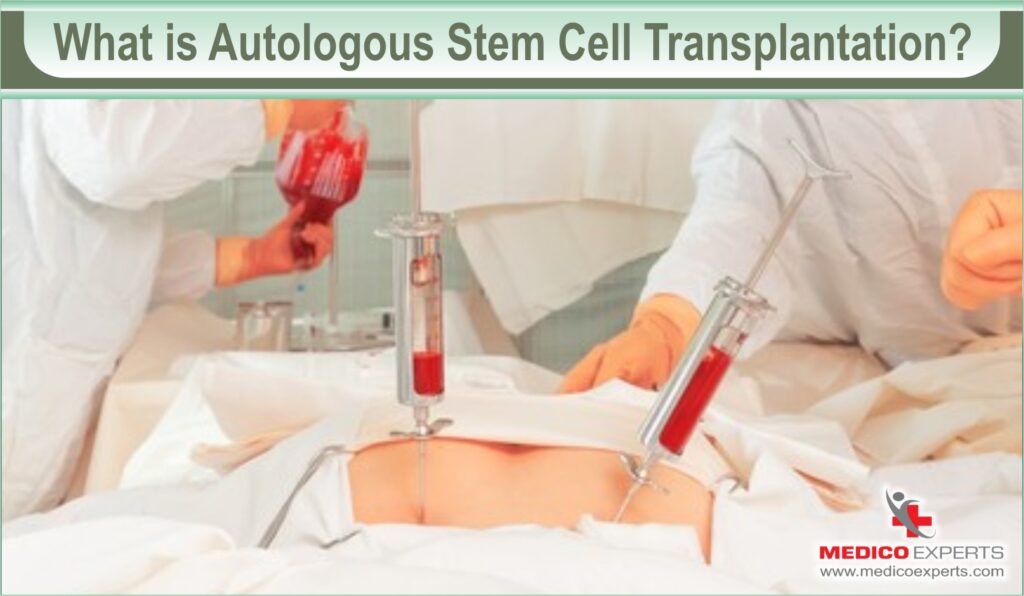Every year, thousands of patients facing blood cancers and other life-threatening diseases turn to autologous bone marrow transplants as a beacon of hope.
Autologous bone marrow transplants are associated with fewer side effects and are less likely to cause life-threatening complications, making them a promising treatment option for certain patients with hematological conditions such as leukemia, lymphoma, and multiple myeloma.
You may suffer from deadly blood cancer but do not lose hope, an autologous bone marrow transplant can save your life and cure your disease completely without any recurrence.
Millions of patients in the last decade have benefitted from autologous bone marrow transplants, making it the most successful medically managed process worldwide.
Let us know about this technique in more detail and understand its success and complications.
What is Autologous Stem Cell Transplantation?

In an autologous transplant, the patient’s blood-forming stem cells are collected from the peripheral blood and then the patient is treated with high doses of chemotherapy. This high-dose chemotherapy or radiotherapy is also called conditioning.
While the intensive treatment aims to eliminate cancer cells, it also kills the remaining healthy blood-producing cells in the bone marrow.
Subsequently, after the chemotherapy procedure, collected stem cells are reintroduced into the patient’s bloodstream, enabling the bone marrow to generate new blood cells.
Autologous Transplant: A Step-by-step procedure

The following step-by-step description gives an insight into what to anticipate throughout the transplant journey.
Stem Cell Collection
In autologous transplantation, physicians typically harvest peripheral blood stem cells (PBSCs) from the patient’s circulating bloodstream. This method, akin to blood donation, proves to be less invasive than extracting cells from the bone marrow, which necessitates surgical procedures or general anesthesia.
Before the blood collection, patients receive a daily medication called G-CSF to enhance stem cell production.
This medication may induce flu-like symptoms and discomfort. In some cases, another drug may be employed during the blood collection to facilitate the movement of stem cells from the bone marrow into the bloodstream for easier collection.
At bone marrow transplant centers, stem cells are obtained using an apheresis machine in the blood donor room, with the collected cells being cryopreserved (frozen) until reinfusion.
Preparing for the Transplant
Once the stem cells are collected and the transplant date is determined, patients undergo chemotherapy, sometimes combined with radiation, to eradicate cancerous cells. The treatment will depend on your condition and your therapeutic needs.
Transplantation and Recovery
Following stem cell reinfusion, the transplanted cells migrate to the bone marrow space, producing new blood cells. Within two to three weeks post-transplant, newly formed blood cells typically become detectable in your bloodstream. Over time, a successful transplant graft leads to the production of red blood cells, white blood cells, and platelets.
In the initial days after the transplant, extensive medical support is required, including antibiotics to prevent and treat infections. Hospitalization for two to three weeks is common after the transplant, with stringent infection control measures in place to minimize the risk of complications.
What’s the success rate for stem cell transplants?
The latest data indicates that the majority of stem cell transplants were performed on individuals with multiple myeloma or Hodgkin and non-Hodgkin lymphoma, with the help of autologous stem cell transplants. Here are the three-year survival rates:
- Multiple myeloma – The data reveals that 79% of patients were still alive three years following the transplant.
- Hodgkin lymphoma- Approximately 92% of individuals who underwent stem cell transplants were alive three years after the treatment. (Most patients undergo transplants due to the recurrence of Hodgkin lymphoma following chemotherapy.)
- Non-Hodgkin lymphoma- Similar to Hodgkin lymphoma, the majority of patients undergo stem cell transplants due to disease recurrence. Among these patients, 72% were alive three years after diagnosis.
Complications of Autologous Stem Cell Transplant
You can have potential complications from the chemotherapy regimen being used. Moreover, there are chances of infections from the bone marrow transplant procedure.
Some of the potential complications are the following:
Bone Marrow Suppression
High-dose chemotherapy directly impairs the bone marrow’s ability to produce white blood cells, red blood cells, and platelets. This often leads to side effects stemming from low counts of these blood cell types, such as anemia, thrombocytopenia, and neutropenia.
You typically require blood and platelet transfusions to address these conditions until the newly transplanted cells begin producing blood cells. By administering an optimum number of stem cells and giving growth factor injections in your body, the recovery of blood cell production can be expedited.
Infections
During the period of approximately two to three weeks required for the new bone marrow to grow and produce white blood cells, you are highly susceptible to infections and you may require the administration of antibiotics to prevent bacterial and fungal infections.
Additionally, the growth factor has been approved by the Food and Drug Administration for use during autologous stem cell transplant, as it increases the rate of white blood cell recovery.
The immune system takes even longer to recover than white blood cell production, leaving patients vulnerable to bacterial, fungal, and viral infections for weeks to months. Following initial recovery from an autologous stem cell transplant, you often need to take antibiotics for an extended period to prevent infections.
Antibiotic administration can help prevent specific infections, such as Pneumocystis carinii pneumonia and certain bacterial and fungal infections, as well as reduce the incidence of herpes zoster infection, which commonly occurs after high-dose chemotherapy and autologous stem cell transplant.
Graft Failure
Graft failure is exceedingly rare in autologous stem cell transplantation. It occurs when bone marrow function fails to return, resulting in bone marrow failure and the absence of red blood cells, white blood cells, and platelet production. This condition leads to infection, anemia, and bleeding.
Cost of Autologous Bone Marrow Transplant in India
The cost of an autologous bone marrow transplant in India varies based on several factors and ranges from approximately 10,00,000 INR to 15,00,000 INR (equivalent to approximately 10,000$ to $15,000 $). The cost is influenced by the type of transplant and the hospital where the procedure is performed.
Role of MedicoExperts in arranging Autologous Bone Marrow Transplant
MedicoExperts play a crucial role in facilitating autologous bone marrow transplants by providing comprehensive support and guidance throughout the entire process. Their involvement encompasses several key aspects.
The organization offers detailed information about autologous bone marrow transplants, including the procedure’s intricacies, potential benefits, and associated risks. They guide you and your family through the treatment journey, ensuring you have a thorough understanding of the process and are equipped to make informed decisions.
MedicoExperts assists in identifying the best hospitals and specialists for bone marrow transplants in India. They consider factors such as cost-effectiveness, trustworthiness, and the specific expertise of medical professionals to ensure that you receive high-quality care.
They provide valuable assistance in financial planning and cost management, helping you navigate the expenses associated with autologous bone marrow transplants.
Conclusion

Performing autologous bone marrow transplants, especially for cancer patients is not a very easy decision. But at the same time, it is the only way to revive your healthy blood cells post-chemotherapy or whole-body irradiation.
Unfortunately, cancer of the blood is not a disease that can be managed or cured without much effort from the physician and the patient. It requires extreme dedication and expertise from medical professionals.
Many times during this long journey of medical treatment, the patient as well as his family gets confused and emotionally disturbed. MedicoExperts not only help in the correct treatment choice for the patient but also help in supporting the family with psychological support.
FAQ :
Q1. Which is better autologous or allogeneic?
A. Both techniques have pros and cons. However, autologous transplant has a lesser chance of graft versus host disease. But, at the same time, an allogenic transplant has a lesser chance of cancer recurrence.
Q2. Is autologous bone marrow transplant safe?
A. Autologous bone marrow transplant has fewer immediate complications than allogenic bone marrow transplants.
Q3. How many stem cells are needed for an autologous transplant?
A. About 4 million stem cells are needed for an autologous transplant.



